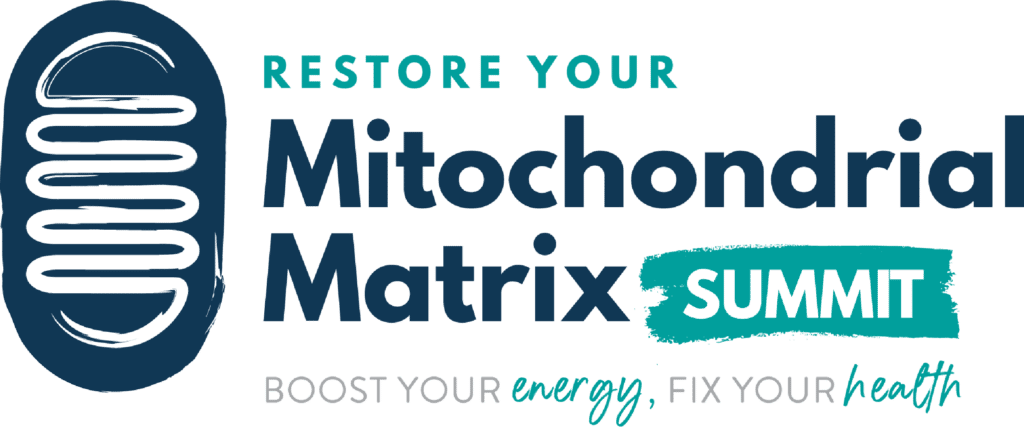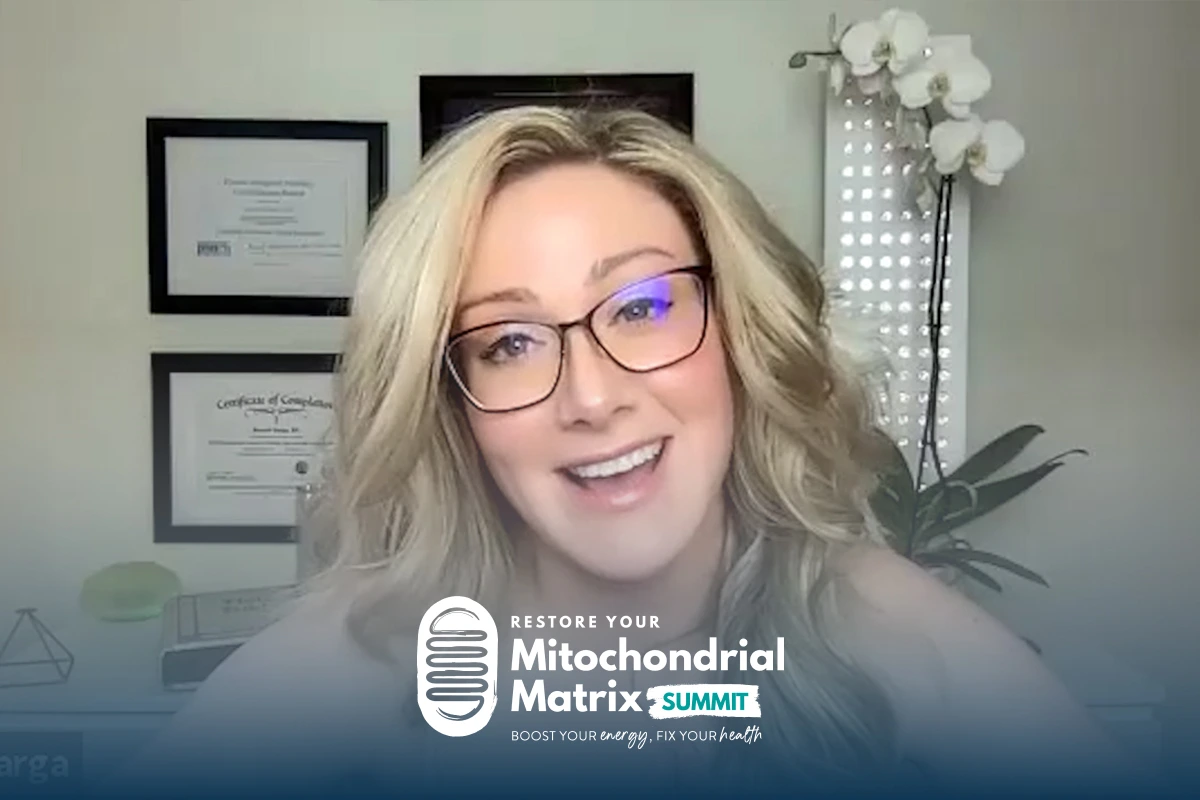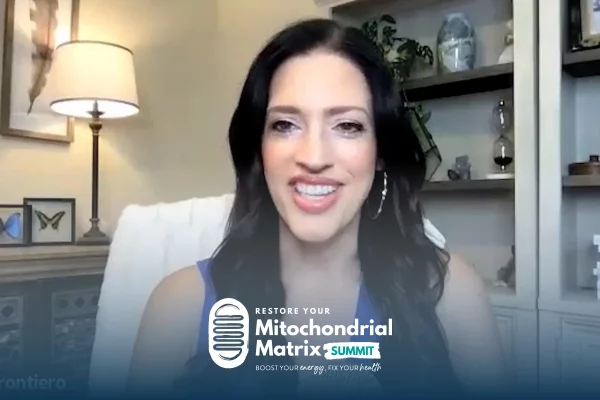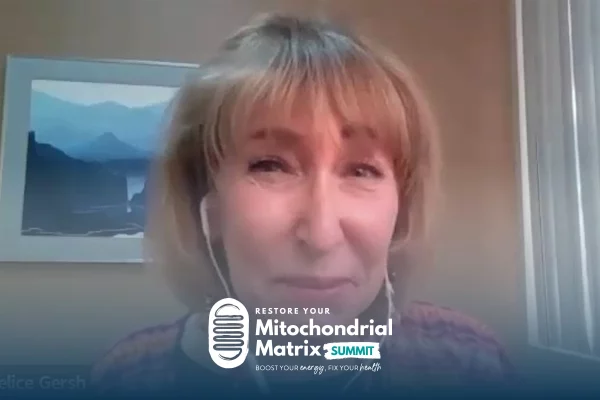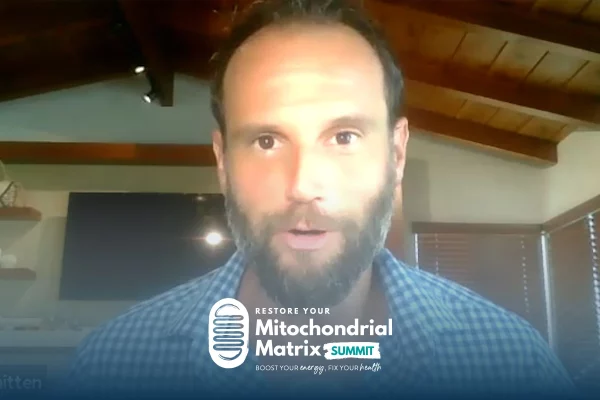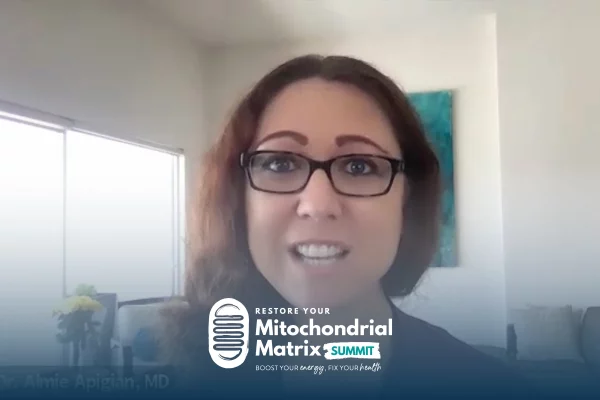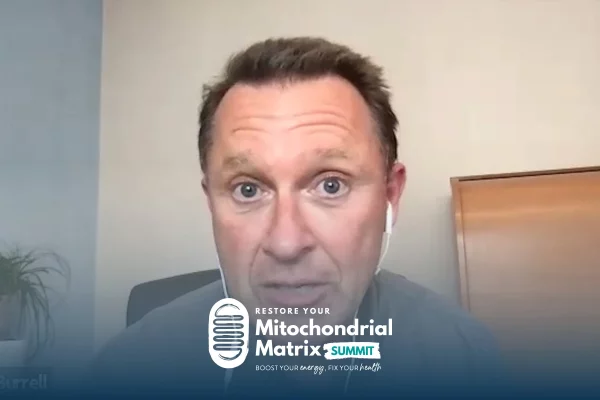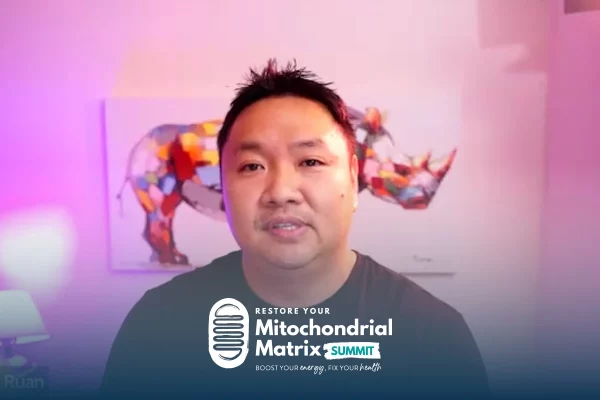Join the discussion below
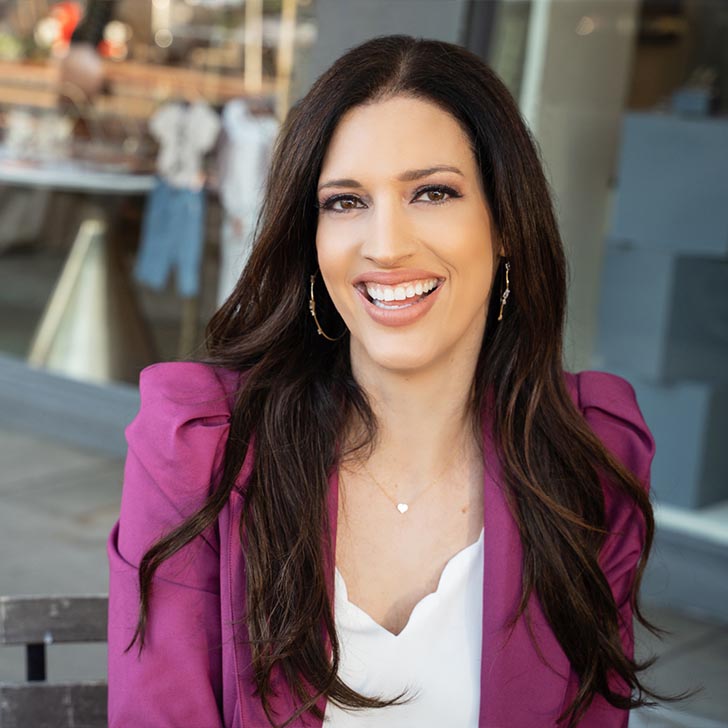
Laura Frontiero, FNP-BC, has served thousands of patients as a Nurse Practitioner over the last 22 years. Her work in the health industry marries both traditional and functional medicine. Laura’s wellness programs help her high-performing clients boost energy, renew mental focus, feel great in their bodies, and be productive again.... Read More
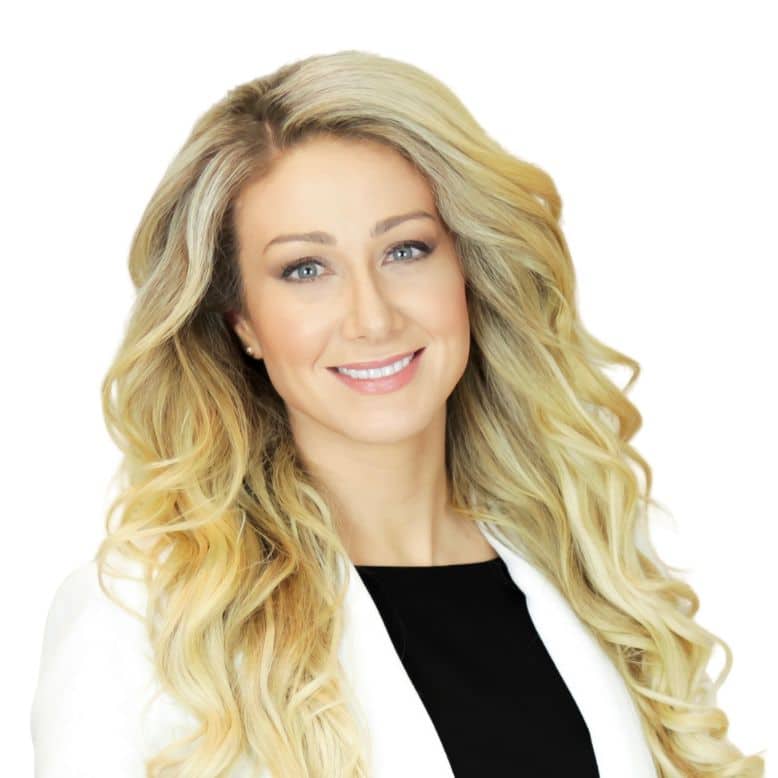
Rachel Varga, BScN, RN, CANS is a Board Certified Aesthetic Nurse Specialist since 2011 with over 20,000 procedures performed, an international clinical trainer for other Physicians and Nurses, celebrity skin expert featured on Bulletproof Radio, Ask the Health Expert Podcast with JJ Virgin, LIVE with Dr. Kellyann Petrucci and Naveen... Read More
- Slowing skin and cellular aging by biohacking your mitochondria
Related Topics
Aging, Anti-aging, BioHacking, Cellular Health, EMF, Inflammation, Mitochondria, Radiance, Skin Health, ToxinsLaura Frontiero, FNP-BC
You’re watching the Restore Your Mitochondrial Matrix Summit. I’m your host, Laura Frontiero and I’m bringing you experts with fresh ideas and proven methods to help you boost your energy and fix your health so you can build the life you love. And today my special guest is Rachel Varga. Hi, Rachel. Welcome to the summit.
Rachel Varga, BScN, RN, CAN
It’s great to be here with you again Laura, it’s great to see your lovely face and I’m looking forward to sharing with everybody here how we could actually slow our aging from the inside out and boost our cellular health.
Laura Frontiero, FNP-BC
I’m so excited to talk about this and I wanna introduce you to the audience. Rachel, you are a board certified aesthetic nurse specialist and you’ve performed over 20,000 procedures. That’s crazy. You’re an international clinical trainer for other physicians and nurses, you’re a celebrity skin expert. You’ve been featured on Bulletproof Radio, Ask the Health Expert podcast with JJ Virgin, Live with Dr. Kellyann Petrucci and a whole bunch of other places. You’re a speaker and a four time academically published award-winning author in the field of plastic and aesthetic nursing, and you’re on the executive board peer reviewer for the Plastic Surgical Nursing journal. So you are well equipped to talk about this subject. I’m so excited. So we’re talking about biohacking mitochondria, slowing aging, improving your skin. We’re gonna get all into that. Start off by telling me why this, what got you into this? There’s so many places in nursing that you could go with your career.
Rachel Varga, BScN, RN, CAN
Yeah. As you know, well, I started out after I graduated from nursing as a pediatric Craig Fentener nurse. So right outta the gate and got into a highly specialized field and I loved doing that work for about two years. But it was very difficult and challenging both, you know, physically and mentally doing that type of work. And then I wanted to perhaps become a physician myself. And so I linked up with an amazing surgeon and he was a highly specialized oculoplastic, so the eyes, so my first paper was on eye rejuvenation. It’s actually one of the first parts of the face that show signs of aging. So I have 10 plus years of experience in that field. And then I started to notice what my most vibrant and radiant clients were doing. So here I am offering these rejuvenation options, loved teaching about it, loved presenting on it for both the client and the clinician, but I thought to myself, why is this one subset of my clients doing, why are they doing so much better than other people who are investing thousands in rejuvenation?
What’s the magic sauce here? So I started to take notes out of their playbook and these were men and women aged 60 to 90. So I started to what I would see them inquire, what types of body, mind, spirit, energy practices they were employing that were clearly impacting their cellular aging and slowing things down. So I basically wrote a book on that, taking notes out of their playbook. And it’s about balancing the body, mind spirit, energy practices. And in the process, you’re actually going to be hitting all these different notes for reducing inflammation because that’s the root cause of aging. In my opinion, it’s inflammaging and inflammation primarily from our exposure to our environment. And then of course, you know, Dave Asprey is a friend of mine. I was just the Asprey Farms yesterday and his sheep bid me hello and goodbye.
It was very sweet. And then biohacking came into my world a number of years ago and I actually recently did my cellular age test and sorry, my biological age versus chronological and I came back at nine years younger than my chronological age. So all this stuff with biohacking, focusing on our cellular health, I think is even more important than what we’re putting on our skin, rejuvenation procedures that we’re doing.
When you couple things first and focus on your mitochondrial cellular health first and foremost, then incorporate good clean skincare that’s free of toxins, parabens, phthalates, sulfates, artificial dyes, fragrances, not tested on animals, that are clean but also work, that’s where someone like myself comes in. And actually right before this I was getting updates on certain ingredients because there’s always shifts in the industry. So it is like part-time job keeping up with all of that stuff, the skin rejuvenation, but also with the biohacking and it’s amazing. It’s crazy what we can do at home now with our skin care and different at home, like dermal rolling and peel options. But of course the in clinic stuff has a place, but I’d say the biohacking, focusing on your cellular health first is really what’s key for setting that foundation.
Laura Frontiero, FNP-BC
This is so good. So what our audiences really got gonna wanna know from you is what biohacks can they do, what can you share with them right now that’s gonna help people get their mitochondria in shape, get healthy, improve your skin, slow aging, have that glow on the outside like you? How do they get skin like yours, Rachel?
Rachel Varga, BScN, RN, CAN
Well, I love that you’re asking this. So we’re gonna talk about biohacking. We’re gonna talk about the glow, but first of all I wanna talk about something called radiance. Radiance is something that I feel like is quickly becoming my life’s work. What is radiance? What is that like je ne sais quoi? When someone like, for example, JJ Virgin enters the room and she’s got this like force to her, she’s got life force. And the other thing is the glow to the skin or the radiance. Obviously that’s even been discussed in spiritual texts, like the one I have behind me, that individual skin actually glowed or their bones vibrated. I think there’s something deeply spiritual to radiance, but from like a biohacking cellular perspective, it’s when your body systems are humming along in the way that it’s meant to be and designed to live.
It’s almost like this egg beater analogy and I’ll get very specific into which biohacking options I think are great for what, but when you’re cellular machinery is like the egg beaters, when they are functioning appropriately as they’re designed to be, they’re actually going to be better able like the mitochondria and your immune system to actually, if we have toxins exposed to our physical form, it will actually be able to just like, nope, not today. And like egg beaters, just spin it out of the way and not allow it to integrate into your cells and undisrupt your DNA and all of that stuff. The other thing that’s really important with cellular aging which I think is key for promoting a glow and promoting radiance is understanding your toxic bucket.
So this toxic bucket analogy especially as we age, when we go through menopause, we tend to, our beauty products are making us sick. I’d say like big Cosmo is just as bad as big food right now and all of that. And we’re putting products on our skin, our hair, cleaning products in our home, our environment, our junk lighting, our, you know, unfiltered air, unfiltered water, our dirty foods with highly rancid toxic oils, all of these are aspects that can add to this toxic bucket. And what happens when that toxic bucket gets full, you’re actually going to be seeing concerns like skin irritation, inflammation, rashes, rosacea, sensitive skin, hyperpigmentation, accelerated aging, accelerated loss of elastin and collagen to the effect where you seem like you’re aging overnight. And I see this with my clients with mold, they have quite a number of issues with their skin and obviously I work with them for that. So let’s talk about biohacking for helping to reduce our toxic load. Doesn’t that sound fun?
Laura Frontiero, FNP-BC
It does. And I like to think of it, especially for women, like biohacking seems like such a dude thing. So we’re bio-optimizing, we’re bio-elevating. Whatever resonates with you, that’s what we’re doing right now.
Rachel Varga, BScN, RN, CAN
That’s actually really funny you mentioned that because obviously part of being beautiful and attractive is very feminine. And when we’re talking about biohacking, yes, this is a male dominated type of field that’s been there for many years. It was just Dave Asprey, it was all guys, right? And now we’re thinking, wait a second. There’s something to this for women’s health, right? I mean, we make up a pretty large population, chunk of the population. So how can we biohack to support our unique feminine needs as well? Because the crazy thing, and I’m glad you brought this up. There’s actually a study in 2018 that looked at the faces of men and women to look at the differences and between the ages of 50 to 60, get this, get this, women’s faces change shape three times faster than men. And that is related to, that’s when women go through menopause, right.
And you might be thinking, okay, what is this Rachel girl in her mid late 30s know about aging? Well, I’ve been working with clients for well over a decade and I’m that type of observer clinician. I see what certain people are doing that’s allowing them to thrive. I see what my clients keep coming back for, what they’re getting results from with their skin and obviously as a researcher, which is really fun. So speaking of research around biohacking, EMFs, I would probably say is one of the biggest instigators of inflamed skin, red itchy, dry skin, and itchy eyes. 50% of the population given my background in ophthalmology, I know these statistics, 50% of the population actually experience dry eye. And if you go on PubMed and you look up EMFs in the skin, you’re gonna quite easily find a study, ’cause if I speak to something I have to mention the study to validate it. It’s very important that we work this way as opposed to just, you know believing information as gospel.
There’s a lot of really not great free information out there. So there actually is a study that EMF exposure contributes to dry eye and eye ear ocular irritation is what that’s called. So when we’re on our laptops here, I have a EMF reader right behind me, of course, ’cause I just went through my house and all my technologies, the laptop I’m on right now, it’s live streaming. It’s actually kicking off as much EMF as my router. And we don’t think of this when we’re working on our devices that we might as well just be sitting next to the router. So really neat thing that I like to do is actually wear EMF, protective clothing as often as I can. And then there are a couple, we’re not gonna talk about brands here, but there are a couple brands where you can actually plug in to that article of clothing. Usually they’re containing things like silver threads, I’m happy to share more on this topic after, but it’s good to stay grounded because when you are grounded from an electromagnetic perspective, I have a background in gen-chem, organic chem, biochem, I love how skincare ingredients feed and nourish the skin, but I’m also really interested and excited to learn about electromagnetics.
So because we’re living in homes and smart cities and stuff like that, we’re not really contacting the earth very much. And Laura, before we started recording, I tell you I’m in the woods three hours out of cell reception, one or two times a week to get that physical grounding because I see the difference in my skin and the reduction of inflammation, less acne, less hyperpigmentation, slower cellular aging. It’s not very convenient if you’re in the Pacific Northwest to stand for 45 minutes barefoot and outside. It’s very cold. My poor feet will freeze for most of the year here ’cause I’m in the Pacific Northwest. So we can actually plug in our clothing to a grounding alley.
You just have to check that it’s grounded and then you’re actually grounding your body. And so here’s how it ties to skin. When we are ungrounded or we’re electromagnetically radiation sick, our red blood cells, I’m actually writing a paper on EMF and its implications to the skin so you’ll be able to find that at some point which is great. But our red blood cells, they should look like nice donuts, right? Obviously we don’t wanna eat sugar and all that stuff but imagine for a moment around donut and that donut carries oxygen to the tissues. It also takes away when it flows, it also takes away toxins. So when we are EMF, when we’re too positive, our electromagnetic, a gradient is kind of messed up and the mitochondria it functions on an electromagnetic gradient. We need to make sure that this electromagnetic gradient is supported as much as possible so that’s why grounding is so important. But when we’re ungrounded, the red blood cells get spiky, they start to stick together and they start to actually form chains.
And so you’re not gonna be getting as good blood flow to your eyes, to your skin, your periphery, your organs. And you’re not gonna be as able to carry out toxins from the periphery like your skin, right? So that’s the link between things like biohacking for reducing your EMF exposure. I think you’re better off shrouding your body and actually wearing protective EMF clothing. Plugging that grounding cord in while I’m sleeping, I’ve noticed much better sleep with EMF protective clothing to the effect I actually got a hundred percent sleep score on one of my tracking devices the first night I slept in that. I even cover my eyes with protective clothing and I have really bad dryitis so that helps. So I would say EMF protection and getting grounded as much as you can to support your red blood cells, we’re talking cellular health healthier for beauty, to support your red blood cells and the caring of oxygen, nutrients, taking away of toxins, that good blood flow to your skin and also that electromagnetic gradient on your mitochondria to allow things to function as it wants to.
Laura Frontiero, FNP-BC
So good, so good. I have another hack for dirty electricity mitigation. So yes, there’s the EMFs coming off of our laptop, our phone. But when you’re sitting here in an office, like you can’t see it right now but I have multiple monitors, multiple computers here. And I have the ability to plug my whole office into a solar battery instead of into the grid on my home, which has dirty electricity. So there’s another way that you can kind of hack this everyone. You can’t see it now, but there is a giant battery behind me and we can charge it on the house or we can charge it with solar panels, which is pretty awesome.
Rachel Varga, BScN, RN, CAN
I love that. I actually, yeah, I took that EMF all through my home, actually one of her friends is an electrician. So I showed him just how much dirty electricity was in my home. And this is gonna be a good segue into the importance of light and air and water in your home because let’s face it, we’re not always gonna be wearing EMF protective clothing. It’s not always the most fashionable. We still have to live our lives, but at least while we’re sleeping, we can get that break. We don’t wanna get too crazy with this stuff, but allowing while we’re sleeping to allow our red blood cells to go back to their, their more ideal state. But the dirty electricity, I think is just something unless you build your house from start to finish like a Faraday cage, something we all have to work with. And there’s actually something that you can plug into your outlets, I’m testing this right now so I’m not gonna get too much into detail, but that can be, there can be mitigation strategies. But wearing stuff I think is great. So no matter where you are in your clothing, I could be on a Zoom call right now, I’d be wearing certain jogger pants that I’m plugged into a grounding outlet.
But other biohacking things for the skin and improving our cellular aging is making sure you have good air purification in your home. I like UV type of catalyzed air purifiers to kill viruses, bacteria, mold. Because when unclean air is, you know, accessing your skin, it’s actually leading to inflammation on the skin and oxidative stress. So having clean air in your home isn’t just so that it smells good. It’s actually gonna impact your skin. In certain countries in the world, especially in the orient where there’s higher rates of air pollution, they have higher rates of acne, acne, rosacea, sensitive skin.
So there’s definitely something to be said for making sure your air, your home is clean. Throw an air purifier in your kitchen, your living space, one in your bedroom, one in your office, should be good. And then water clean water. There’s so many rabbit holes you can go down with making sure your water is purified for your whole home or like a faucet in your kitchen. I use reverse osmosis. Then I’ll go one step further and structure it and also dirty lighting. So LEDs in your home, you can switch those all out to halogen right away, except for studio lighting obviously because the LEDs were getting inside. The blue light, get this, you might say, oh, I don’t leave the house, I don’t need to wear sunscreen. That’s not true. The blue light LEDs is actually penetrating three times deeper into the skin than the UVA on the cloudy days and the UVB on the sunny days are giving you.
Laura Frontiero, FNP-BC
That’s crazy. Yeah.
Rachel Varga, BScN, RN, CAN
Isn’t it though?
Laura Frontiero, FNP-BC
Yeah, so you’re sitting in your office building at your desk, working, thinking I don’t need to put sunscreen on today.
Rachel Varga, BScN, RN, CAN
Think again.
Laura Frontiero, FNP-BC
Yeah, crazy.
Rachel Varga, BScN, RN, CAN
And the skin is the largest organ of your body which is why I love learning how we can care for it because every other organ in our body is connected to the skin in some way. If you get skin cancer, it can metastasize into other things. So it’s not just about having pretty skin. It’s about having a well functioning organ that you’re protecting from external toxins which will then have a downstream, not just topical effect, but downstream internal cellular health effect. So it’s all about just being aware of your toxins, not getting too crazy with it, but there’s so many wonderful biohacking options specifically for the skin and slowing aging. The root cause is you’re reducing inflammation.
Laura Frontiero, FNP-BC
Absolutely. So we kind of have this vanity metric of I want my skin to be youthful and glowing, but it’s so much more than that is what I’m hearing you say.
Rachel Varga, BScN, RN, CAN
It is. And once to be completely honest with you, I was just as brainwashed as the other aesthetic nurse and plastic surgeon that the most important thing is your skin care, the most important thing is showing up for your lasers a couple of times a year. Actually, I would go so far as to flip that on its head and saying your cellular health is really first and foremost. You can’t have great skin if you’re inflamed, if your cells are not happy, if your cells are not supported, your skin is constantly re-replicating itself. So if you want good skin, you gotta pay attention to the inside.
Laura Frontiero, FNP-BC
Yeah, and I think people know, I think they’re pretty clear on, well, if I drink a lot of alcohol that’s probably bad for my skin. If I’m smoking, that’s bad for my skin. If I’m, you know, exposed to a high level of toxins in the air, water, that’s bad for my skin. But I don’t think people know enough about what can you do to slow cellular aging with supplements for the skin. So can you touch on that? Talk a little bit about that kind of piece that people maybe don’t know so much about.
Rachel Varga, BScN, RN, CAN
Absolutely. So let’s also while we’re here talk about supplements for the skin and also super clean skincare that’s marketed as green and all natural that’s just as toxic. You would be shocked at the ingredients I come across. So when I do a consult one on one session for a client, I actually like to go through the products that they’re using. It gives me brand awareness as what my clients are potentially buying anyways and there’s always these crazy ingredients that I come across when I’m doing this work. Because I like to let my clients know, okay, you should definitely stop using this product because it has chemical sunscreen filters or parabens, phthalates, sulfates, artificial dyes, fragrances, or other weird ingredients like nitrates, like BPA, like tin, DNA.
Trust me, I’ve seen these ingredients even just in the last couple months from some of the biggest brands you probably already know about and redirect them towards clean products that are going to work. This is really important. We want them to be clean but we also want them to deliver what our mature skin needs. And from a skin supplement perspective, the three keys that I’ve personally noticed big improvements with acne, hyperpigmentation, you and I, Laura, we of a specific skin type where we can go outside and we cannot tan to save our lives. We can burn very easily and so when you actually are taking certain supplements, it will actually give you a little bit of protection against photosensitivity because your body’s better able to manage DNA stress and radiation. It’s very fascinating.
So I actually recently did a study for a French based company, I’m not gonna mention specific brand names in this, but I followed about eight clients for six to eight weeks. And then another surgeon on the other side of the country did the same thing. And while we noticed with the combination of super oxide, dismutase, antioxidants omegas, couple other key factors, co-factors, is reduction of redness to the eyelids so less puffiness to the eyelids, less inflammation to the corners of the nose and the cheeks and even sun spots or age spots starting to fade even as soon as three weeks. I have clients emailing me and saying, hey, I’m noticing actually a difference within like two to three weeks. But for the study I did, I like to look at them at about six to eight weeks and it was just across the board. So antioxidants, omegas and collagen, I would say are the top three supplements that you should be taking for your skin health promotion, but the type of collagen does matter as well.
Laura Frontiero, FNP-BC
I thought, I was gonna ask. So there’s so much about taking animal collagen, plant collagen, powdered collagen, liquid collagen. What kind of collagen matters?
Rachel Varga, BScN, RN, CAN
Well, collagen, my understanding has to come from animal skin. So when you hear about collagen coming from a plant source and by all means, send me an email if I’m wrong and need to be corrected because things are constantly evolving, but my understanding is that collagen supplement does need to be derived from animal skin and through different bio, okay, biohacking again, different biohacking gut tests we can determine what type of collagen someone might respond better to. So there’s beef collagen, there’s chicken collagen, and there’s fish collagen as like the three main sources of collagen. I’m a bigger fan of beef collagen to be completely honest because I see this in some of my clients’ reports that they do better with beef rather than poultry and fish. What do you find?
Laura Frontiero, FNP-BC
Actually, I haven’t studied it. So I’m deferring to you on the expert on this, but somebody recently in the health space was talking about some kind of liquid collagen being better. And I don’t know. I have to go research it more and find out but something about a liquid collagen being better or a, like a sea plant derived collagen, and I don’t know enough about it. So more to come on that.
Rachel Varga, BScN, RN, CAN
I would say, it’s the collagen that number one, if you can do gut testing to see if it’s gonna be beef, poultry or marine as being better for you. Personally, I do better with beef so you can do that analysis of yourself. And then also which one you’re actually gonna take, right? So then there’s, unflavored, there’s flavored, there’s mixed. For example, I have a tumeric one that’s amazing. It’s like a golden elixir latte, but based on some client’s gut test, turmeric can be inflammatory. So that’s where people like Laura and I come in. We can help you determine which one will be able to suit your needs. ‘Cause sometimes clients like to just put their collagen powder in anything and so they don’t think about it. You can throw different flavored ones in smoothies, but then you don’t have to worry about like what’s the flavors or the mixing of it. So a lot of my clients are on a lot of these over the counter, easy access brands and they don’t always mix very well. So I take that into account when I’m making recommendations.
Laura Frontiero, FNP-BC
Yeah, yeah. It’s such a big topic. And truthfully, what you just said, the best one is the one you will take. There’s so much truth to that on so many levels for so many things.
Rachel Varga, BScN, RN, CAN
And also making sure that it’s non-GMO and grass fed, especially with beef. I trust products, I work with about 15 different practitioner grade brands and I have worked with a lot of these brands for over 10 years. I don’t have my own line of things yet but I am pulling on my biochemistry background to formulate as we speak, but it’s a long process. So I really like working with specific skin supplements that have been formulating for 15 to 30 years but new technologies are always coming out. But it’s, there’s a lot to know when formulating and making sure that it’s, you’re gonna get results from it. The dosage for collagen also that’s something to talk about maybe as well is about 2.5 milligrams of collagen. And I like to actually double that, and actually one of my favorite collagens and I know it works for me ’cause it’s ’cause of this, one of my favorite collagens, the tumeric one, has been on back order for like a month and a half so I’ve been out of it. And the crazy thing is I have more pain in my body now. Like my joints feel it, I’m getting a, like some breakouts again. So it’s kind of interesting when you do little experiments on yourself.
Laura Frontiero, FNP-BC
Yeah. Or unintentional experiment of not-
Rachel Varga, BScN, RN, CAN
Yeah.
Laura Frontiero, FNP-BC
Being able to get product which seems to be the norm now with… So if there’s something you love, stock up on it is the, and keep a stock. Keep a stock.
Rachel Varga, BScN, RN, CAN
The other… The other thing that it’s worthwhile mentioning is notice how long, when we’re talking about skin and inflammation and supplements, notice how long in cellular health, this is how you know your body is dealing with inflammation effectively is notice how long it takes for a breakout to go away. Is it a couple of days, couple of weeks or couple of months. The faster it goes away, like a couple of days is an indicator your body’s managing inflammation well. Say for example, you can be a little bit klutzy like myself. And I burnt myself with my reverse osmosis hot water on demand and this was a brutal burn and I’m taking certain antioxidants and omegas and I am amazed at how fast this has recovered.
Because in the past, before I was doing biohacking and like just the very traditional rejuvenation clinic type stuff, I would burn my hand all the time with curling my hair. And I would have a burn mark for months that I would then have to laser off with a light based laser to lighten that pigment and break apart the reds and browns in the skin. And now they’re going away quickly. So seeing how fast you respond, with certain skin supplements, working on your cellular health and all of that will better equip your body for dealing with stressors like if you burn yourself or things like that.
Laura Frontiero, FNP-BC
Yeah.
Rachel Varga, BScN, RN, CAN
And you can see the progress.
Laura Frontiero, FNP-BC
And something important to note here is if you’re seeing that on the outside, what you can actually notice on the outside, imagine how quickly you’re restoring and healing on the inside. So what we haven’t talked about is the importance, we’re talking, you know, Rachel is a skin and anti-aging specialist. When you’re talking about collagen, it’s really important for the gut lining as well. And for the joints and you were mentioning you’re starting to feel some joint discomfort after being off the collagen. It could be tumeric too ’cause it’s so anti-inflammatory but collagen is helping you restore at a faster rate everywhere inside your body. And when you’re on a health journey and you’re removing toxins and you’re restoring health, every time you pull toxins outta your tissues, it leaves a little mark there that needs to be repaired where that toxin was adhered to in the tissues, in the cells and so that collagen is gonna help restore. So what’s happening on the outside is most certainly happening on the inside too. So good.
Rachel Varga, BScN, RN, CAN
Yeah, I know. It’s just, it’s fascinating when you start to become really in tune with your body and you say have an injury, like something as simple as a burn on your skin from curling your hair. By the way, barely curling my hair anymore. I do heatless overnight curling. I always see my dear grandmother pin her hair back and now that’s me. Because even you have to think about, you have to think about this. Are your beautification practices making you sick? Like getting your nails done, like getting your hair done, like getting your lashes done. And this is a huge thing that women almost have to just have a conversation with themselves. Why are they doing these things? Is it for themself or do they think it makes them more attractive to the opposite sex? Talking about ’em masculine and feminine. When I used to do my nails in the bathroom, my husband would say, oh my gosh, that’s stuff stinks. Get it outta here.
Laura Frontiero, FNP-BC
Yep.
Rachel Varga, BScN, RN, CAN
And so then I stopped doing my nails. I keep them short, I keep them clean. Number one, I’m a double board certified aesthetic nurse specialist. You would hope I wouldn’t have these bacteria filled nail extensions but I also do a lot in nature. So I’m getting my feet in the dirt, my hands in the dirt. I work on my own four by four vehicle when I need to. And so you have to also think function, but I’m saving a lot of money and I’m also not exposing myself to toxins. And then not using like aerosolized hairspray. Trust me, if you need recommendations for clean hair care, I’ve got you. It’s very difficult to find clean hair care these days. I’ll go into the beauty supply stores. There’s 50 brands there. There’s only two brands that I would go anywhere near. One for, one brand for hydration, color, scalp care and the other for hair stimulation. And I go into these warehouses sometimes and people that work there like Rachel, what are your recommendations now? ‘Cause they see me going through and literally like reading every single ingredient.
Laura Frontiero, FNP-BC
I know it’s so bad. I’m with you. I stopped doing my nails ages ago. Stopped doing so many, I don’t do eyelashes. None of it. My latest thing is I keep wanting to have my brows done like permanent and then I’m thinking, oh how toxic would that be. Better to just keep shading them in?
Rachel Varga, BScN, RN, CAN
Why don’t we talk about that for a second? So, have you ever heard of the 80/20 rule?
Laura Frontiero, FNP-BC
Go for it.
Rachel Varga, BScN, RN, CAN
Okay, sure. We can live our lives and be as healthy and pure as possible but sometimes there just might be something that you want to do because you’re thinking about it, you got special, maybe you wanna get your eyelashes done, maybe you wanna get your brows done. Actually, two of my best friends run a microblading studio where I live so I’ve been able to learn a about the inks that are used. Some of them are better than others. I think it really comes down to actually finding practitioners like Laura and myself, like your lash and brow artists, like your hair stylist that go to a natural hair salon.
You can seek out these like gems of people that actually care about this stuff because like I said, I just got off the call right before this with one of my skincare reps. And because I’d asked her about specific ingredients that I’ve just been hearing some weird things about, I was like, I wanna know it’s not coming from like shark liver. I wanna know where it’s from, how it’s sourced and something that I wasn’t too keen on as a preservative to keep something stable. I wanted just some more information. She’s like, nobody asked me these questions. Like last week I went through 75 products that I work with the ingredients list and did inventory of that because things can sometimes be reformulated. It’s really frustrating when that happens, when you find things you like, and then it reformulates.
So I do that and people don’t do that in the industry. She told me she’s like, I work with a lot of accounts and nobody really cares about this as much as you do. But the thing is is that that toxic bucket analogy, say, you wanna get your brows done, say you wanna do some facial rejuvenation whether that’s laser or other non-surgical injectables, there’s lots of options. Some are much cleaner than others I will definitely say that and I’m more than happy to speak to that if, if you like. But I was gonna get something done tomorrow, but I had a little bit of a rash pop up on my skin so I canceled, right? And so what I’m promoting in my research papers on rejuvenation is to have this like good faith health exam.
How are you feeling today? And looking for signs of inflammation. If you were feeling inflamed, if you’re noticing, say a rash on your skin for whatever reason, periocular redness to your eyes, puffiness to your eyes that’s unusual. Is your body dealing, do you have like a histamine response going on? We have spring so that’s probably what’s going on with me is my histamine are just a little outta whack. But understanding that you can do things that might have a little bit of a toxic flow to you but only if your toxic bucket is as empty as possible because you add one more thing to that it’ll tip over. You’ll have issues. So only ever choose to do things that may add a layer of your toxicity when you’re feeling well. And I am actually promoting awareness of this to fellow aesthetic practitioners too, because it’s just not something that’s talked about at all.
Laura Frontiero, FNP-BC
No.
Rachel Varga, BScN, RN, CAN
Even known about in the industry.
Laura Frontiero, FNP-BC
Yeah, it’s not. It’s so good, you’re such a wealth of information, Rachel. I really appreciate everything that you’re sharing. As we wrap up here do you have any final words that you wanna share with our audience and also let us know where we can find you? ‘Cause I know you have a podcast and you’re wealth of information. I mean, you talked about so many things that I’m sure people are like, what about, what products should I use? We didn’t talk about products on this talk. So where can they find you to get more information?
Rachel Varga, BScN, RN, CAN
Yeah, well the long and short of that is it gotta be customized. So for sure you can reach out for a one-on-one session with you. Everything about me you can find at rachelvarga.ca and the Rachel Varga podcast where I focus on body, mind, spirit, energy practices to bring forth a higher level of radiance and beauty. I would say the most important thing that you should take away from what Laura and I have talked about is the toxic load, the toxic bucket analogy and to be as less inflamed as possible in regards to your body, mind, spirit and energy. When you are less inflamed and less toxic and your cells are humming just the way that they’re meant to be, you’re going to be your most, truest, clearest, version, not authentic, but your most cleanest, purest, version. You’re going to have more mental energy, you’re going to have a little bit more of that, like glow or radiance or like that spark start to develop in your interactions with yourself and others and the spaces around you.
Don’t downplay the importance of getting in nature, getting that physical activity, communing in nature and having some type of meditative practice, spiritual practice. But don’t downplay the importance of looking after your body in the physical form, which is what Laura you’re so fantastic talking about but also things that light you up and bring you joy in the mental, spiritual, and energetic sense. But the energy piece for skin, the energetic electromagnetics spiritual component for skin, I think that’s really where the radiance lies. And yeah, I just see this, I see clients in their 60s to 90s that work with me and they feel really good on the inside, but they look at themselves on the outside, they’re like, I feel like it doesn’t match.
But those are the people that are already doing the heavy lifting. So when they’re less inflamed, they’re doing body mind, spirit, energy practices. And then we employ different, you know, skincare products for them that I’ve determined to be just right for them. And in a way that’s just right for them with their budget lifestyles and their values, then they’re actually gonna respond better to skincare, at home dermal rolling and potentially even some in clinic stuff. So I give my clients a plan for all of that. It’s a lot of fun and just avoid those skin toxins. Look at your products, throw out everything and anything that has parabens, phthalates, sulfates, artificial dyes, and fragrances.
Laura Frontiero, FNP-BC
Mm, those are the big ones.
Rachel Varga, BScN, RN, CAN
And, chemical sunscreen filters. If you’re looking at your sunscreen, your BB cream, your tinted sunscreen moisturizer, look for the medicinal ingredients. If it has anything other than zinc and titanium, you need to throw it out. Those are hormone disruptors.
Laura Frontiero, FNP-BC
Such good advice. Such good advice. Definitely, I shifted years ago when I first met you. Zinc is the only thing that’s going on this face. So good. Thank you so much Rachel for imparting all your wisdom and just your true love for what you do it shines through. Thank you so much.
Rachel Varga, BScN, RN, CAN
Okay. Thanks for having me. Look forward to meeting some of you.
Laura Frontiero, FNP-BC
I know.
Downloads
